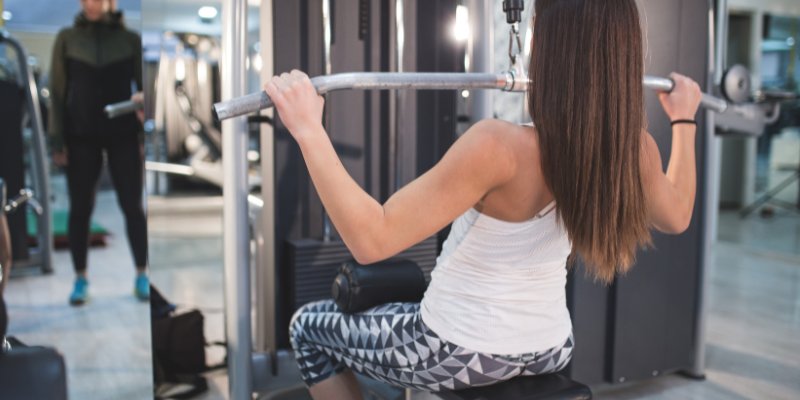Creative Lats Workouts to Strengthen Your Upper Body
Dec 07, 2023 By Nancy Miller
To build a strong back, you must use specific lat workouts and be aware of typical obstacles. Latissimus dorsi, which gives the back its V-shaped curve, thrives on a variety of activities, from regulated resistance band pull-downs to difficult pull-ups. This holistic technique activates many lat muscle groups and adds diversity to your exercise, keeping your muscles engaged and receptive to challenges.
As we examine the importance of these must-do lat workouts, we must also avoid missteps that might impair your training. In addition to variation, good form throughout each exercise is essential to ensure the lats sustain the necessary burden and decrease injury risk.

Creating Your Lat Workout:
To build a defined back, you need an effective lat exercise. Lats, the broad muscles that provide your back a V-shaped look, must be deliberately targeted for a complete upper body exercise. Include breadth and thickness movements in your lat workout. Isolation exercises may supplement pull-ups, lat pulldowns, and rows for balanced training. To challenge your lats and expand them, adjust your training to your fitness level and progressively increase intensity.
When designing your last exercise, focus on form and technique. Activities with proper posture enhance muscular activation and decrease injury risk. Try varied grips and hand positions to stimulate different lat muscles. Consistency is crucial to creating strong, defined lats, so design a training schedule that suits your fitness objectives and overall exercise plan.
Safety and Precautions:
Lat sculpting is gratifying, but safety measures must be taken throughout the exercises. Make sure your shoulders and core are warmed up before doing lat workouts. Warming up boosts muscle blood flow, making them more flexible and decreasing stresses and injuries.
To prevent back and shoulder tension, watch your technique throughout lat workouts. Use your core muscles to maintain your spine and avoid momentum. Should you be new in lat exercises or have pre-existing issues, see a fitness expert to ensure adequate technique and a plan that suits your fitness level. Respect your own body, and don't overdo it, particularly if you're hurt. Stretch plus mobility exercises may supplement your lat workout to minimize stiffness and increase flexibility.
How Often Should You Train Your Lats?
Your last training frequency relies on your fitness objectives, recuperation capabilities, and workout program. Two to three lat workouts a week are good for muscle development and definition. This provides enough muscle-building stimulation and healing time.
People react differently to training frequency. Others may benefit from longer recuperation times or more frequent lat exercises. Watch how your body reacts and modify your workout frequency. It's important to balance effort with rest to avoid overtraining, which may slow growth and cause injury. As with any fitness routine, persistence and steady growth are essential to lat training success.
How Long Does it Take to Build Lats?
Building well-defined lats takes time and depends on genetics, exercise intensity, and training response. While observable improvements may take time, constant work and devotion may generate them. With a well-structured training plan, lat definition and strength may increase between weeks to months.
Building lats requires patience to avoid overtraining or unsustainable techniques. Focus on back muscular strength and endurance as well as aesthetics. Muscle-building also depends on diet, sleep, and lifestyle. A comprehensive approach to fitness and consistent lat training may lead to enduring improvements and a sculpted, muscular back.
Must-Do Exercises to Work Your Lats:
Resistance Band Pull Down
Resistance band pull-downs are adaptable and practical lat exercises. By pushing a resistance band down toward your hips, you activate your lats. This technique replicates the lat pulldown machine, delivering resistance throughout the range of motion and building back strength and definition.
Renegade Row
Lat training with renegade rows is dynamic. This dumbbell plank workout works your lats and core. Rowing each dumbbell to your hip strengthens your lats, shoulders, and upper body.
Elevated Plank Row
The raised plank row targets lats while enjoying plank advantages. Rowing a dumbbell in a plank position with your hands on an elevated platform targets your lats and stabilizes your shoulders and core.
Pull-Ups
Pull-ups are the best lat workout. Pull-ups work the latissimus dorsi and other muscles using body weight. Use varied grips to target different lats and increase difficulty as you strengthen.
Supermans
Supermans are a bodyweight exercise that activates and strengthens the lats by targeting the lower and middle traps. Lifting your arms and legs while lying face down engages the posterior chain, enhancing back balance.
Shoulder Extension
Shoulder extension with cables or dumbbells is essential for lat development. Pulling your arms down and back activates your lats fully. This workout strengthens muscles and defines the back.
Mistakes to Avoid While Performing Lats Exercises:
Neglecting Proper Form
Avoiding appropriate forms during lat workouts is typical. Incorrect format reduces training efficacy and increases injury risk. Maintain proper posture, engage your core, and control each action to maximize outcomes and minimize danger.

Using Excessive Momentum
Momentum rather than muscle activation is a common lat training mistake. Try not to swing or jerk while lifting weights. Focus on controlled and purposeful actions to make your lats work harder.
Ignoring Range of Motion
Exercises with a restricted range of motion limit lat activation. Take each movement to its greatest extent to stretch and contract muscles. This maximizes muscle engagement and growth.
Overlooking Mind-Muscle Connection
Not establishing a solid mind-muscle link might slow your growth. Feel the last contraction throughout each exercise. This relationship improves training efficacy and muscle engagement and development.
Conclusion:
You can strengthen your back by doing the must-do lat exercises. Resistance band pull-downs, pull-ups, and supermans target the latissimus dorsi. These exercises stimulate multiple lat angles and muscle fibers for healthy development. Pull-ups and supermans build functional strength and muscle. Variety in movement patterns keeps your lats challenged and makes a strong back. Avoid typical mistakes that hinder progress to optimize these exercises. Good form helps the lats handle the load and reduces injury risk. Slowing down and focusing on each movement enhances lat exercises.







